
Choosing Your Smile: A Deep Dive into Dental Bonding and Veneers
Deep dive: dental bonding versus veneers. Compare procedures, cost, and aesthetics to choose your perfect radiant smile.
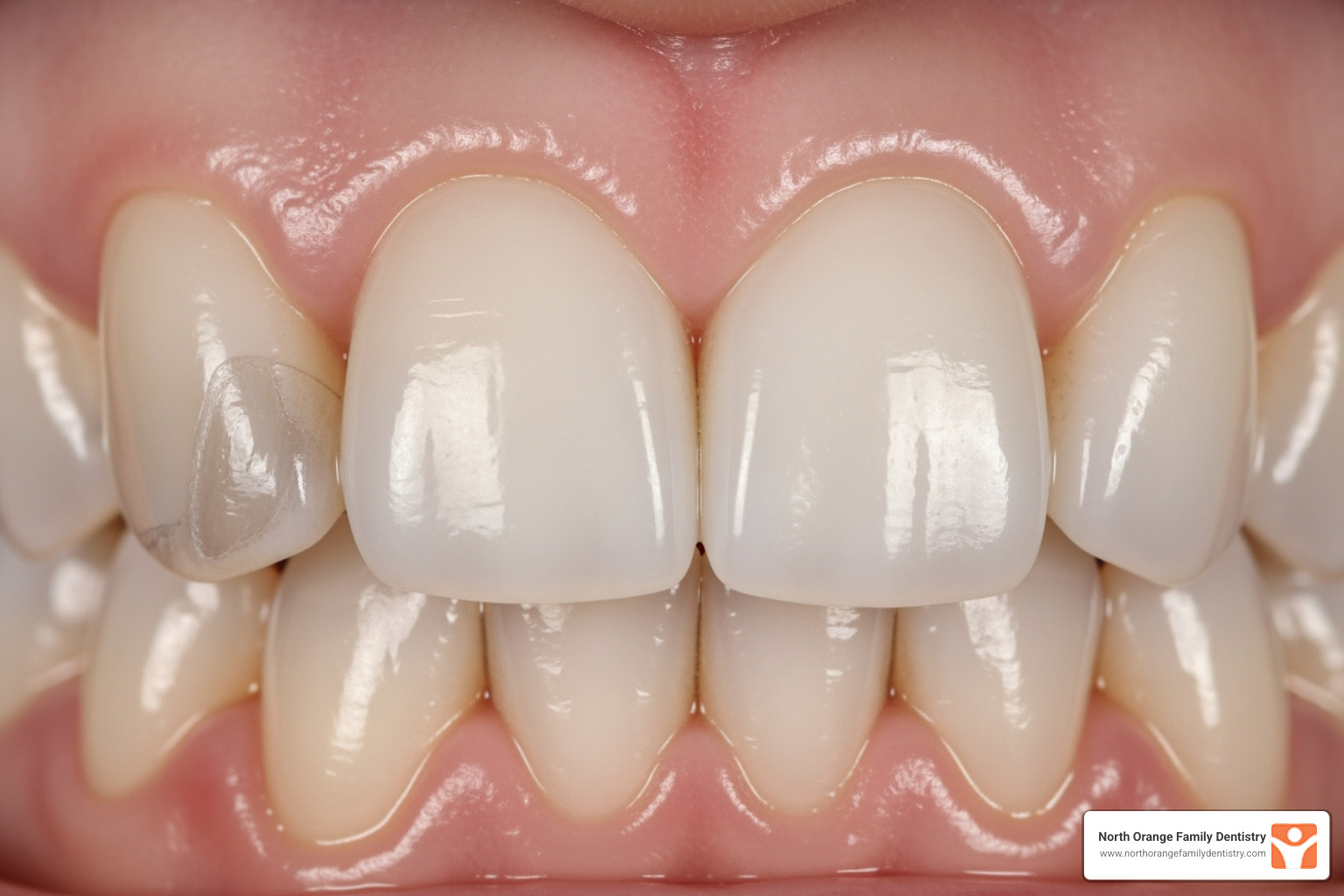

Your Path to a Radiant Smile
Dental bonding versus veneers is a common decision in cosmetic dentistry. Both procedures can transform your smile, but they work in different ways. Dental bonding uses a tooth-colored resin applied directly to your teeth, while veneers are thin, custom-made shells that cover the front surface of your teeth. The choice depends on your specific needs, budget, and desired outcome.
Quick Comparison: Dental Bonding vs. Veneers
| Factor | Dental Bonding | Veneers |
|---|---|---|
| Material | Composite resin | Porcelain or composite shells |
| Time | 30-60 minutes, one visit | 2-3 visits over 1-2 weeks |
| Lifespan | 5-10 years | 15-20 years |
| Invasiveness | Minimal tooth preparation | Requires enamel removal |
| Best For | Minor chips, gaps, stains | Major cosmetic changes, severe discoloration |
| Reversible | Yes | No |
I'm Dr. Kyle Bogan, founder of Advanced Smiles Marion and a Fellow in both the International College of Dentists and Academy of General Dentistry. With experience in cosmetic dentistry, I've helped countless patients steer the dental bonding versus veneers decision. My goal is to help you understand which option will best meet your unique needs.
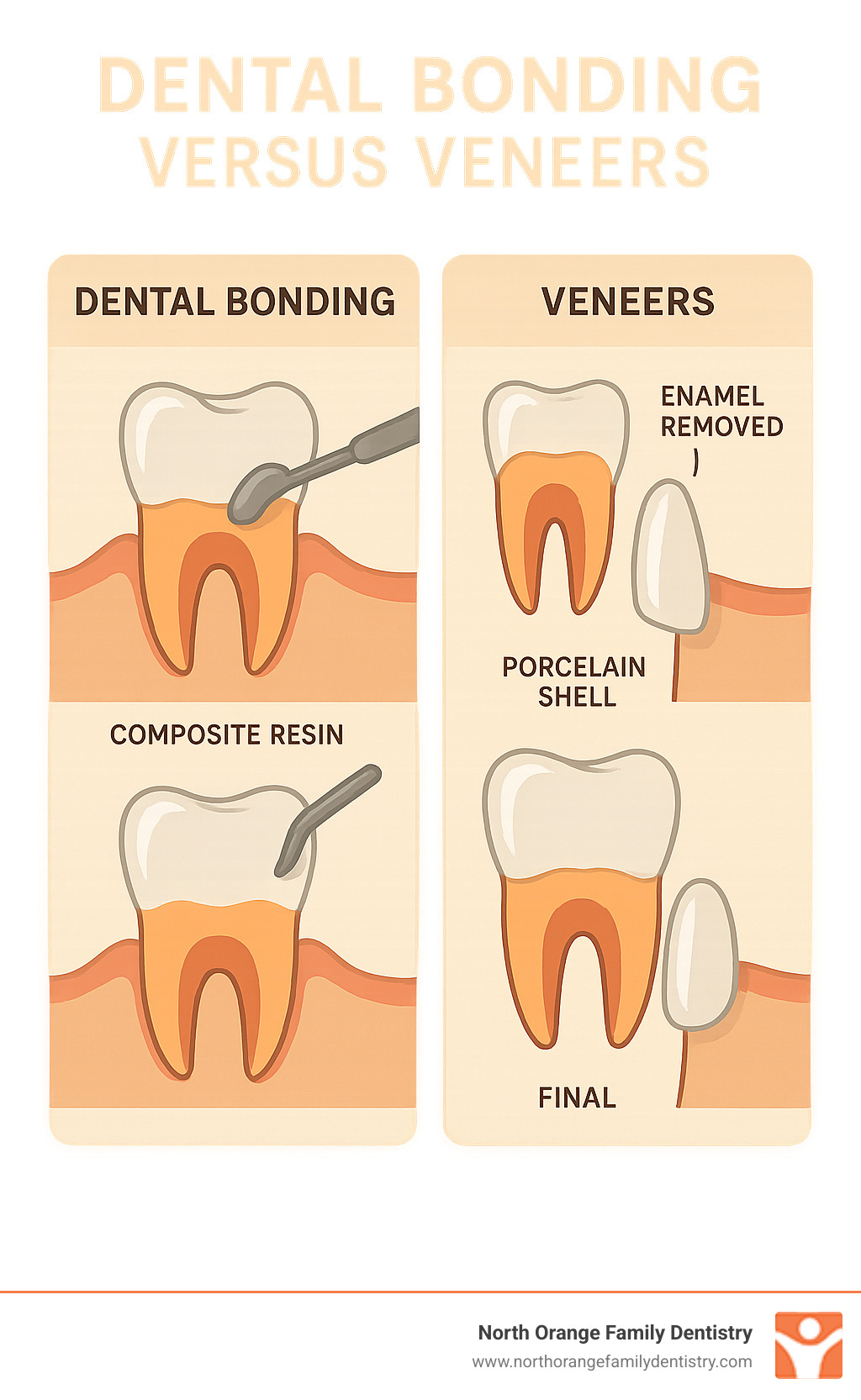
Key terms for dental bonding versus veneers:
Dental Bonding Versus Veneers: A Detailed Comparison
What Are They? Understanding the Procedures
When considering how to improve your smile, it's important to understand the difference between dental bonding versus veneers.
The Art of Dental Bonding
Dental bonding is a procedure where a tooth-colored composite resin is applied directly to a tooth, then sculpted into the desired shape. The process is straightforward: we gently etch the tooth's surface, apply a conditioning liquid, and then mold the color-matched resin. A special light hardens the material, and a final polish makes it shine. The entire process takes about 30-60 minutes per tooth in a single visit. It's a minimally invasive treatment that typically requires no anesthesia and preserves your natural tooth structure. Learn more on our What is Dental Bonding? page.
The Precision of Dental Veneers
Veneers are thin, custom-made shells designed to cover the front of your teeth. Porcelain veneers, the gold standard, are crafted in a dental lab for a precise fit and appearance. The process begins with removing a thin layer of tooth enamel (about half a millimeter) to accommodate the veneer. We take impressions, send them to the lab, and you may wear temporary veneers while your permanent ones are made. In a second visit, we bond the final veneers to your teeth. The result is a durable, stunning smile change. There are also composite veneers, which are sculpted directly onto the teeth in a single visit, similar to bonding but covering more surface area.
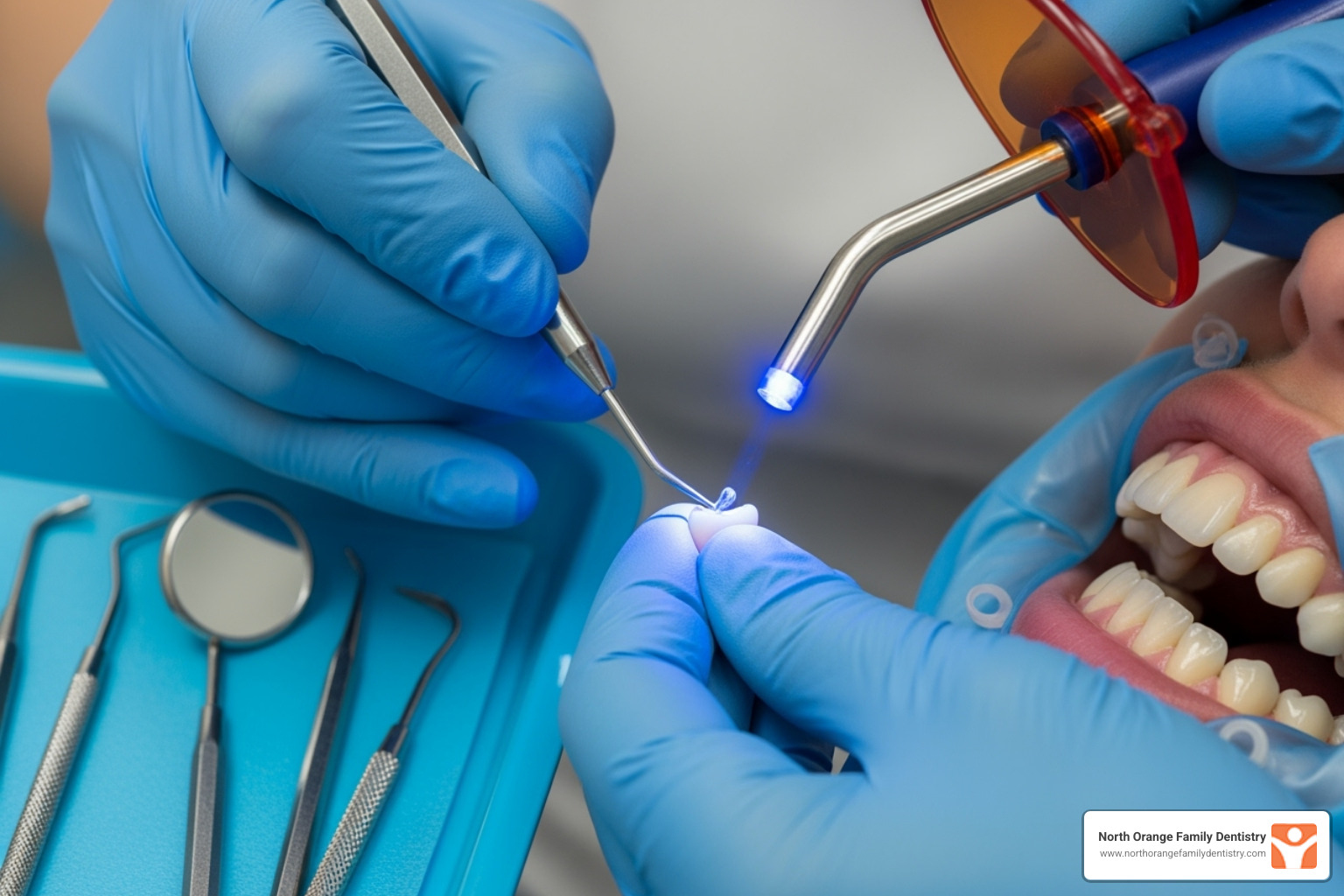
The key difference is that veneers require a permanent alteration to your teeth, a trade-off many find worthwhile for dramatic results. Explore our veneer options at Advanced Dentistry: Dental Veneers.
The Core Differences: Materials, Durability, and Cost
When comparing dental bonding versus veneers, the materials used are a key factor in their performance and longevity.
What Makes Each Treatment Unique
Dental bonding uses a composite resin, the same material used for tooth-colored fillings, which can be sculpted and color-matched in-office. Porcelain veneers use a high-quality ceramic material known for its strength and natural, enamel-like translucency. Composite veneers use the same resin as bonding but are applied over a larger area.
How Long Will Your Investment Last?
Dental bonding typically lasts 5 to 10 years. The resin is durable but can chip or stain over time. Porcelain veneers are the most durable option, often lasting 15 to 20 years or more with proper care due to their strength and stain resistance. Composite veneers generally last 5 to 7 years. Good oral hygiene and avoiding habits like chewing ice will extend the life of either treatment.
Making It Affordable for Your Family
Cost is a major consideration. Dental bonding is the most budget-friendly option. Composite veneers cost more than bonding, while porcelain veneers are the largest upfront investment due to the lab work and premium materials. However, the longer lifespan of porcelain veneers can make them more economical over time. At North Orange Family Dentistry, we offer a Dental Wellness Plan for patients without dental insurance. This plan provides yearly dental care at a discounted price, making quality treatments more accessible. Learn more about costs on our How Much Does a Dental Bonding Cost? page.
Aesthetic Results: Comparing the Look and Feel
For dental bonding versus veneers, the final look is paramount. Both can improve your smile, but they offer different levels of aesthetic quality.
The Natural Look Factor
Dental bonding provides excellent, seamless results for small fixes. However, the composite resin is more opaque than natural enamel. Porcelain veneers excel at mimicking the translucency and light-reflecting properties of natural teeth, creating a vibrant, authentic appearance. This difference is most apparent in full smile makeovers, where veneers provide superior uniformity and natural beauty.
The Staining Reality
The composite resin used in dental bonding can stain over time from coffee, tea, or tobacco. A key limitation is that bonded areas cannot be whitened. If you whiten your natural teeth, the bonded tooth will no longer match. In this case, the bonding would need to be replaced. Porcelain veneers, on the other hand, are highly resistant to staining. Their non-porous surface prevents pigments from causing discoloration, ensuring your smile stays consistently bright for years.
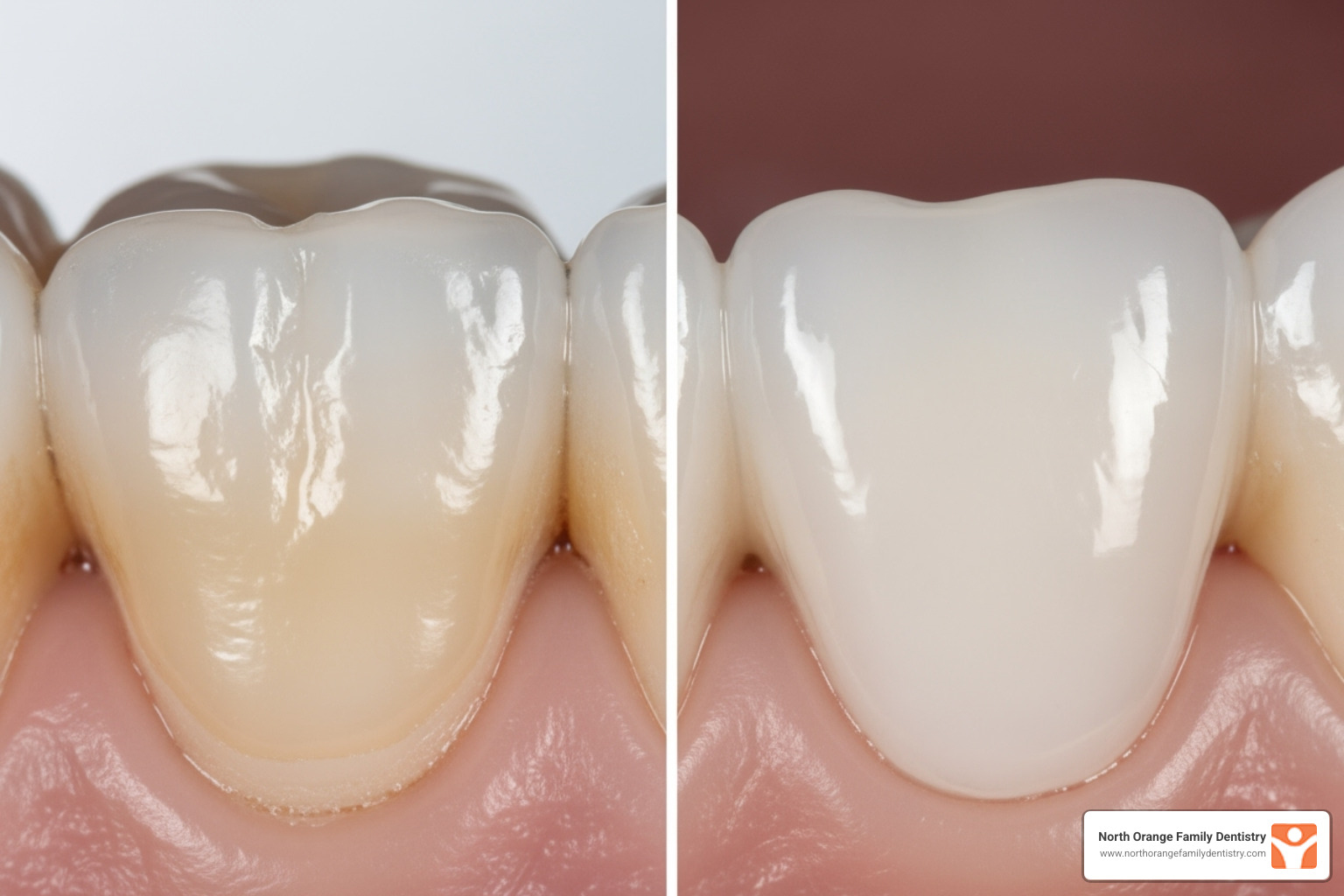
The Patient Experience: Invasiveness, Time, and Reversibility
Understanding the treatment process for dental bonding versus veneers is crucial for making a comfortable choice.
How Much of Your Natural Tooth Is Affected?
Dental bonding is a conservative treatment that requires little to no removal of your natural tooth structure. We only lightly etch the surface to help the resin adhere. Veneers, particularly porcelain, require removing a thin layer of enamel (about 0.5mm) from the front of the tooth. This is a permanent alteration.
Time Investment and Convenience
Dental bonding offers immediate results, with most procedures completed in a single 30-60 minute appointment per tooth. Porcelain veneers require more time, typically involving two or three appointments over one to two weeks to allow for lab fabrication.
The Reversibility Question
This is often a deciding factor. Dental bonding is generally considered reversible because it preserves the original tooth. You can learn more on our Is Dental Bonding Permanent? page. Veneers are not reversible. Once enamel is removed, the tooth will always need a covering, such as a new veneer or a crown. This permanence requires careful consideration.
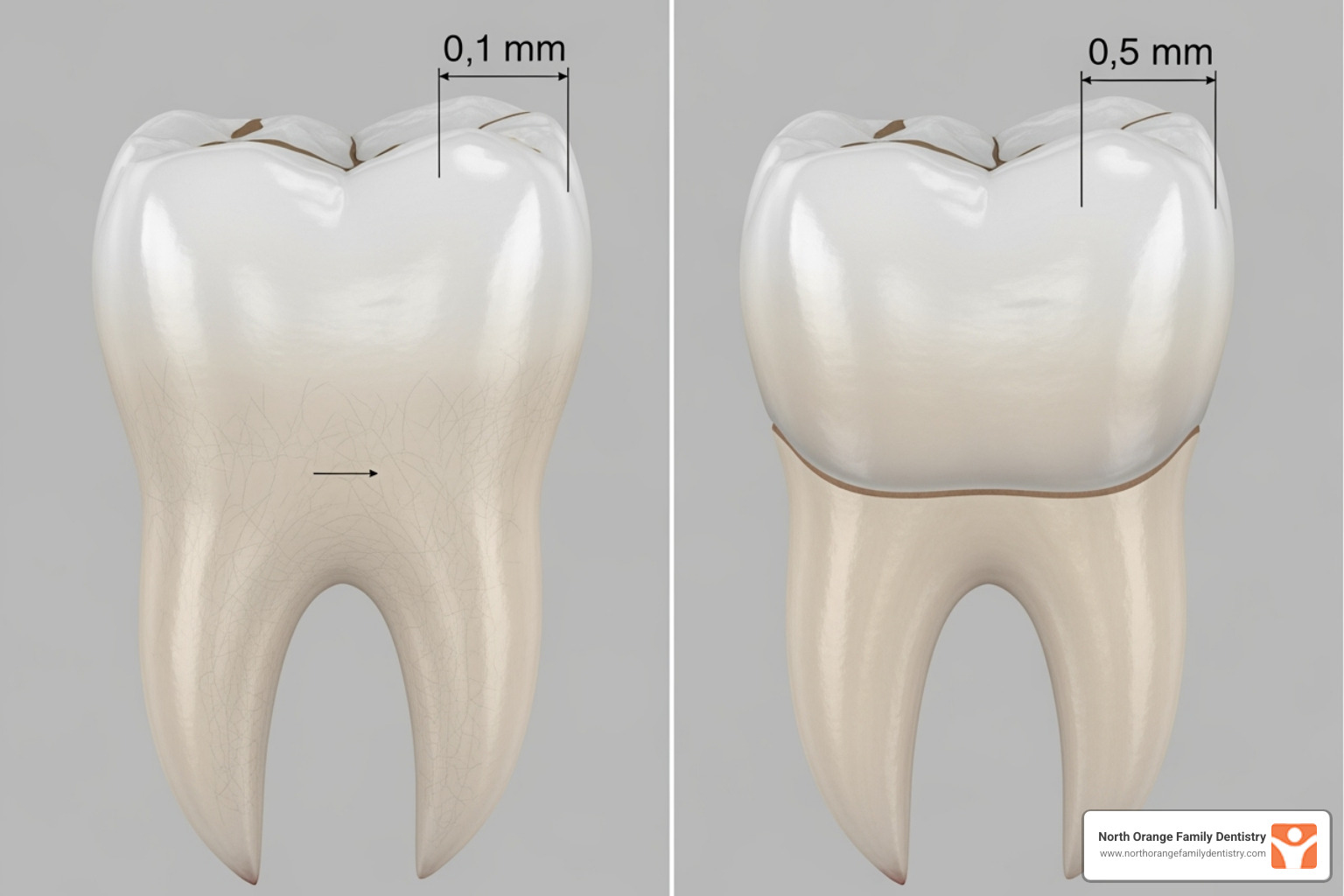
Which is Right for You? A Guide to Dental Bonding Versus Veneers
Choosing between dental bonding versus veneers depends on your specific goals.
When Dental Bonding Shines
Bonding is ideal for targeted, minor improvements. It excels at fixing:
- Small chips or cracks
- Minor gaps between teeth
- Isolated stains or discoloration
- Slightly misshapen or uneven teeth
- Exposed tooth roots from gum recession
Bonding is perfect for those who want quick, affordable results with a conservative, reversible approach.
When Veneers Are the Answer
Veneers are the better choice for comprehensive smile changes. They are exceptional for addressing:
- Severe, deep stains and discoloration
- Larger gaps or mild to moderate alignment issues
- Worn-down, short, or eroded teeth
- Multiple aesthetic concerns requiring a uniform result
- Extensive chips or damage beyond what bonding can repair
Making Your Personal Decision
We generally recommend bonding for minor cosmetic issues and for patients who prefer a reversible, budget-friendly solution. We suggest veneers for those seeking dramatic, long-lasting changes with the most natural-looking results, especially on the front teeth. The best way to decide is through a consultation where we can assess your unique situation and smile goals. Learn more about our services at Cosmetic Dentist Lewis Center.
Making Your Decision and Next Steps
Combining Treatments and Final Considerations for Dental Bonding Versus Veneers
Your ideal smile might not be an either-or choice. In fact, many stunning smile makeovers are achieved by strategically combining dental bonding versus veneers.
Can you combine bonding and veneers?
Yes. This approach allows for a completely customized treatment plan. For example, you might choose porcelain veneers for your highly visible front teeth to achieve maximum durability and stain resistance, while using cost-effective dental bonding to correct minor flaws on adjacent teeth. This lets you invest where it matters most visually while addressing all your concerns.
The importance of professional consultation
No article can replace an in-person consultation. The best choice between dental bonding versus veneers depends on your oral health, smile goals, and budget. During your consultation at North Orange Family Dentistry, Dr. Kyle Bogan will perform a comprehensive exam and create a personalized treatment plan. We use advanced technology, including laser treatments for TMJ pain, canker sore healing, and periodontal disease treatment, to ensure your cosmetic work is built on a healthy foundation. Explore our approach at Erase Imperfections and Release Radiance with Cosmetic Dentistry or learn about our Advanced Dentistry: Tooth Bonding services.
Additional Services and Support at North Orange Family Dentistry
At North Orange Family Dentistry, we are a comprehensive dental home for your entire family, serving Lewis Center, Delaware, and the greater Ohio area.
Beyond cosmetic dentistry
While you may be interested in dental bonding versus veneers, we offer a full spectrum of services to meet all your family's needs. Our services include:
- Invisalign for discreet teeth straightening
- TMJ pain solutions, including advanced laser therapy
- Professional teeth whitening
- Dental implants, crowns, and root canal therapy
- Oral hygiene and wellness check-ups
- Modern digital dentures
- Botox for cosmetic and therapeutic use
When emergencies happen
We provide emergency dental treatments and can see patients the same day in most situations. Whether you have a chipped tooth or severe pain, our team is here to help when you need it most.
Making quality care affordable
For patients without dental insurance, our Dental Wellness Plan makes care more accessible. This plan helps you and your family get the yearly dental care you need at a discounted price. Dr. Kyle Bogan and our team are committed to providing a five-star experience and supporting your oral health for years to come.
Your Path to a Radiant Smile
Dental bonding versus veneers is a common decision in cosmetic dentistry. Both procedures can transform your smile, but they work in different ways. Dental bonding uses a tooth-colored resin applied directly to your teeth, while veneers are thin, custom-made shells that cover the front surface of your teeth. The choice depends on your specific needs, budget, and desired outcome.
Quick Comparison: Dental Bonding vs. Veneers
| Factor | Dental Bonding | Veneers |
|---|---|---|
| Material | Composite resin | Porcelain or composite shells |
| Time | 30-60 minutes, one visit | 2-3 visits over 1-2 weeks |
| Lifespan | 5-10 years | 15-20 years |
| Invasiveness | Minimal tooth preparation | Requires enamel removal |
| Best For | Minor chips, gaps, stains | Major cosmetic changes, severe discoloration |
| Reversible | Yes | No |
I'm Dr. Kyle Bogan, founder of Advanced Smiles Marion and a Fellow in both the International College of Dentists and Academy of General Dentistry. With experience in cosmetic dentistry, I've helped countless patients steer the dental bonding versus veneers decision. My goal is to help you understand which option will best meet your unique needs.

Key terms for dental bonding versus veneers:
Dental Bonding Versus Veneers: A Detailed Comparison
What Are They? Understanding the Procedures
When considering how to improve your smile, it's important to understand the difference between dental bonding versus veneers.
The Art of Dental Bonding
Dental bonding is a procedure where a tooth-colored composite resin is applied directly to a tooth, then sculpted into the desired shape. The process is straightforward: we gently etch the tooth's surface, apply a conditioning liquid, and then mold the color-matched resin. A special light hardens the material, and a final polish makes it shine. The entire process takes about 30-60 minutes per tooth in a single visit. It's a minimally invasive treatment that typically requires no anesthesia and preserves your natural tooth structure. Learn more on our What is Dental Bonding? page.
The Precision of Dental Veneers
Veneers are thin, custom-made shells designed to cover the front of your teeth. Porcelain veneers, the gold standard, are crafted in a dental lab for a precise fit and appearance. The process begins with removing a thin layer of tooth enamel (about half a millimeter) to accommodate the veneer. We take impressions, send them to the lab, and you may wear temporary veneers while your permanent ones are made. In a second visit, we bond the final veneers to your teeth. The result is a durable, stunning smile change. There are also composite veneers, which are sculpted directly onto the teeth in a single visit, similar to bonding but covering more surface area.

The key difference is that veneers require a permanent alteration to your teeth, a trade-off many find worthwhile for dramatic results. Explore our veneer options at Advanced Dentistry: Dental Veneers.
The Core Differences: Materials, Durability, and Cost
When comparing dental bonding versus veneers, the materials used are a key factor in their performance and longevity.
What Makes Each Treatment Unique
Dental bonding uses a composite resin, the same material used for tooth-colored fillings, which can be sculpted and color-matched in-office. Porcelain veneers use a high-quality ceramic material known for its strength and natural, enamel-like translucency. Composite veneers use the same resin as bonding but are applied over a larger area.
How Long Will Your Investment Last?
Dental bonding typically lasts 5 to 10 years. The resin is durable but can chip or stain over time. Porcelain veneers are the most durable option, often lasting 15 to 20 years or more with proper care due to their strength and stain resistance. Composite veneers generally last 5 to 7 years. Good oral hygiene and avoiding habits like chewing ice will extend the life of either treatment.
Making It Affordable for Your Family
Cost is a major consideration. Dental bonding is the most budget-friendly option. Composite veneers cost more than bonding, while porcelain veneers are the largest upfront investment due to the lab work and premium materials. However, the longer lifespan of porcelain veneers can make them more economical over time. At North Orange Family Dentistry, we offer a Dental Wellness Plan for patients without dental insurance. This plan provides yearly dental care at a discounted price, making quality treatments more accessible. Learn more about costs on our How Much Does a Dental Bonding Cost? page.
Aesthetic Results: Comparing the Look and Feel
For dental bonding versus veneers, the final look is paramount. Both can improve your smile, but they offer different levels of aesthetic quality.
The Natural Look Factor
Dental bonding provides excellent, seamless results for small fixes. However, the composite resin is more opaque than natural enamel. Porcelain veneers excel at mimicking the translucency and light-reflecting properties of natural teeth, creating a vibrant, authentic appearance. This difference is most apparent in full smile makeovers, where veneers provide superior uniformity and natural beauty.
The Staining Reality
The composite resin used in dental bonding can stain over time from coffee, tea, or tobacco. A key limitation is that bonded areas cannot be whitened. If you whiten your natural teeth, the bonded tooth will no longer match. In this case, the bonding would need to be replaced. Porcelain veneers, on the other hand, are highly resistant to staining. Their non-porous surface prevents pigments from causing discoloration, ensuring your smile stays consistently bright for years.

The Patient Experience: Invasiveness, Time, and Reversibility
Understanding the treatment process for dental bonding versus veneers is crucial for making a comfortable choice.
How Much of Your Natural Tooth Is Affected?
Dental bonding is a conservative treatment that requires little to no removal of your natural tooth structure. We only lightly etch the surface to help the resin adhere. Veneers, particularly porcelain, require removing a thin layer of enamel (about 0.5mm) from the front of the tooth. This is a permanent alteration.
Time Investment and Convenience
Dental bonding offers immediate results, with most procedures completed in a single 30-60 minute appointment per tooth. Porcelain veneers require more time, typically involving two or three appointments over one to two weeks to allow for lab fabrication.
The Reversibility Question
This is often a deciding factor. Dental bonding is generally considered reversible because it preserves the original tooth. You can learn more on our Is Dental Bonding Permanent? page. Veneers are not reversible. Once enamel is removed, the tooth will always need a covering, such as a new veneer or a crown. This permanence requires careful consideration.

Which is Right for You? A Guide to Dental Bonding Versus Veneers
Choosing between dental bonding versus veneers depends on your specific goals.
When Dental Bonding Shines
Bonding is ideal for targeted, minor improvements. It excels at fixing:
- Small chips or cracks
- Minor gaps between teeth
- Isolated stains or discoloration
- Slightly misshapen or uneven teeth
- Exposed tooth roots from gum recession
Bonding is perfect for those who want quick, affordable results with a conservative, reversible approach.
When Veneers Are the Answer
Veneers are the better choice for comprehensive smile changes. They are exceptional for addressing:
- Severe, deep stains and discoloration
- Larger gaps or mild to moderate alignment issues
- Worn-down, short, or eroded teeth
- Multiple aesthetic concerns requiring a uniform result
- Extensive chips or damage beyond what bonding can repair
Making Your Personal Decision
We generally recommend bonding for minor cosmetic issues and for patients who prefer a reversible, budget-friendly solution. We suggest veneers for those seeking dramatic, long-lasting changes with the most natural-looking results, especially on the front teeth. The best way to decide is through a consultation where we can assess your unique situation and smile goals. Learn more about our services at Cosmetic Dentist Lewis Center.
Making Your Decision and Next Steps
Combining Treatments and Final Considerations for Dental Bonding Versus Veneers
Your ideal smile might not be an either-or choice. In fact, many stunning smile makeovers are achieved by strategically combining dental bonding versus veneers.
Can you combine bonding and veneers?
Yes. This approach allows for a completely customized treatment plan. For example, you might choose porcelain veneers for your highly visible front teeth to achieve maximum durability and stain resistance, while using cost-effective dental bonding to correct minor flaws on adjacent teeth. This lets you invest where it matters most visually while addressing all your concerns.
The importance of professional consultation
No article can replace an in-person consultation. The best choice between dental bonding versus veneers depends on your oral health, smile goals, and budget. During your consultation at North Orange Family Dentistry, Dr. Kyle Bogan will perform a comprehensive exam and create a personalized treatment plan. We use advanced technology, including laser treatments for TMJ pain, canker sore healing, and periodontal disease treatment, to ensure your cosmetic work is built on a healthy foundation. Explore our approach at Erase Imperfections and Release Radiance with Cosmetic Dentistry or learn about our Advanced Dentistry: Tooth Bonding services.
Additional Services and Support at North Orange Family Dentistry
At North Orange Family Dentistry, we are a comprehensive dental home for your entire family, serving Lewis Center, Delaware, and the greater Ohio area.
Beyond cosmetic dentistry
While you may be interested in dental bonding versus veneers, we offer a full spectrum of services to meet all your family's needs. Our services include:
- Invisalign for discreet teeth straightening
- TMJ pain solutions, including advanced laser therapy
- Professional teeth whitening
- Dental implants, crowns, and root canal therapy
- Oral hygiene and wellness check-ups
- Modern digital dentures
- Botox for cosmetic and therapeutic use
When emergencies happen
We provide emergency dental treatments and can see patients the same day in most situations. Whether you have a chipped tooth or severe pain, our team is here to help when you need it most.
Making quality care affordable
For patients without dental insurance, our Dental Wellness Plan makes care more accessible. This plan helps you and your family get the yearly dental care you need at a discounted price. Dr. Kyle Bogan and our team are committed to providing a five-star experience and supporting your oral health for years to come.

Contact Us
Have any questions? Want to learn more?


